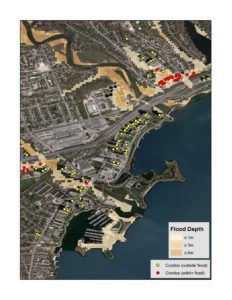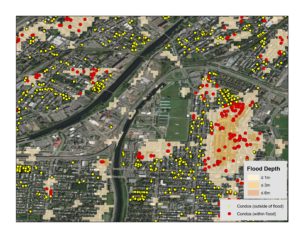Top Finance Execs Discuss Industry Hot Topics
In an increasingly digitized world, data carries undeniable clout. At once the source of insight into optimizing business operations, data analytics also supports the development of products and services that were unimagined before as new sources of social and sensor information – and the technology to manage it – come online.
But if the vision for data potential is coming into sharper focus, for many organizations, the actual integration of new volumes and variety of data to create business value is less clear. In this situation, the sharing of experiences with data successes and ongoing challenge can serve as a useful tool to galvanize discussion and ultimately more successful deployment of data and analytics solutions. Within a specific industry, this sharing can take on added import as common language and circumstance create quick sympathy – a phenomenon demonstrated in the June installment of DMTI Spatial’s Strategic Insights Sessions, at which key players in the financial sector considered top of mind issues in the use of analytics in banking and insurance.
Data Analytics in Finance
To kick off this month’s pre-game session at the Rogers Centre in Toronto, DMTI invited four panelists to outline their involvement with different analytics projects. These presentations provided a springboard for session attendees to discuss their own knowledge and experience of data practices. Like the topics covered in the panel presentations, conversation in post-panel breakout sessions was animated and broadly based. Several key themes arose in the panel, breakouts and Q&A segments, however, that reveal much about the current state of data analytics adoption.

Analytics-based customer experience vs. privacy
In her presentation, Susan Doniz, global chief information officer for provider of marketing and loyalty analytics solutions Aimia, lead with the notion of ‘customer experience’, a buzz topic in the industry that is an increasing preoccupation of customer facing organizations that are on the cutting edge of service delivery.
According to Doniz, loyalty programs based on sophisticated analytics can help businesses understand the consumer, but the key is to use data to do things for people rather than for the business alone. She provided a couple of examples – UK-based grocer Sainsbury, which analyzed what people were buying to discover who might be prone to heart conditions and hence improve targeting for medication and wellness marketing campaigns, and Sephora, which developed “Inform” analytics to remind customers what they had bought in the past to ease the shopping experience – in order to introduce issues around this practice of ‘personalization’.
While personal information can inform service delivery, Doniz argued that consumers today also want transparency around how their data is being used, the ability to turn the data flow off, as well as information on who has accessed their personal data. Largely a government responsibility, the privacy of personal data is also a challenge for CIOs, she argued, who typically do not have a lot of experience in this area. What kinds of limits should be placed on information sharing, what is necessary to collect and what institutions do consumers trust with information like a “digital ID” are all questions that still need to be resolved.
Cloud a panacea for Big Data requirements?
CFO for Kognitive Marketing Atif Ansari made a strong case for creating customer experience through the use of cloud computing, illustrating the benefits of this data delivery approach through description of his work with Bank of America. Ansari asked: “performance measurement takes a long time…. how do you simplify it, [and move data from back office systems] so that it serves the front office who can use it to better serve customers”?
Since bank transactions are typically managed on a quarterly basis, Ansari explained that traditionally it has been necessary to build huge computing systems that were not attuned to this kind of schedule, but could provide capacity when demand was at peak. While this practice is common, it is extremely costly. As a result, the bank moved to cloud, dramatically reducing the costs associated with data housing and management (savings in the millions Ansari added), while also delivering instant access to data for field workers. The financial investment advisor, for example, who is now able to access cloud data to show the customer everything about his individual portfolio in real time in the field.
Ansari acknowledged security and data residency concerns around cloud technology that linger in this sector, but argued that now that service providers can delivery virtual private cloud, located in Canada, there is increasing adoption of cloud within the financial services industry. Ansari’s perspective on cloud was not universal, however, and other session attendees voiced more reservation. For example, Curtis Gergley-Garner, chief risk officer at Canada Guaranty Mortgage Insurance Co., noted that cloud tends to be problematic at his organization since it works with bank data, and the banks in turn require that Canada Guaranty systems be as robust as their own: banks need to become comfortable with cloud data first, before insurers take this step, he insisted.
Similarly, Dion Yungblut, VP at Capital One, observed that while people are moving to cloud, the banks and regulators are not really there; a leader’s job, he said, involves understanding how stay on top of that – how to take advantage of “exponential growth of access to data and computing” and to to create “nimble IT infrastructure” if cloud is not ubiquitous. To clarify, Brad Struthers, director of collateral management and strategic alliances at RBC, pointed to the importance in this debate of separating out cloud computing and cloud storage, which may have different security management requirements. Lack of understanding issues like this, he added, may be preventing banking organizations from tapping into new technologies.
Tech for operational efficiencies
David Bradshaw’s data story was one of growth management. As the VP, client business support at Tangerine bank, explained, the Tangerine group predicted their transactional volume was going to grow by 48 percent with ramp up of operations, and built a “scalability model” based on Excel spreadsheets to figure out how to prevent operating costs from growing at the same rate. This model helped Tangerine to identify the areas that were going to expand most quickly, and which would benefit most from process optimization. Areas such as deposits, where manual management of fuzzy screen cheque photos proved a real bottleneck, as did the mailroom, mortgages and payments.
Through this analytics exercise, the organization was also able to estimate the potential savings that could be gained via the replacement of manual processes with technology, and to plug tools in to achieve significant improvements in focus areas like the mailroom. By streamlining processes and identifying the proper software tools to help increase operational efficiency and speed time to market, Tangerine managed to increase volumes by 45 percent with no increase in operating costs.
Fill in the right data blanks
Curtis Gergley-Garner from Canada Guaranty launched his presentation with the observation that as a relatively new company in the mortgage insurance space with two very large competitors that have a lot more data than they do, the firm has to be very efficient with the data they do have.
From a business perspective, the goal of Canada Guaranty’s data strategy was to improve the efficiency, consistency and speed with which mortgage applications are approved, decrease the cancellation rate (as frustrated customers look elsewhere), improve customer service, ultimately, the overall quality of Canada Guaranty credit. To achieve this, the firm mounted in two specific data projects. One involved the creation of a proprietary scorecard, based on trended credit bureau information over five quarters, which enhanced the company’s ability to predict forward default. On the property side, Canada Guaranty also worked with DMTI Spatial to implement the Location Hub platform, which addresses problems with ambiguous addressing through the Unique Address Identifier (UAID) standard, and by analysing the address quality in a customer data set based on automated error checking.
As Gergley-Garner explained, when individuals input address data, it’s not uncommon for errors to occur; by the same token, it is difficult to achieve an “automated value model” when address data is wrong and easy to “miss a lot of hits” in address search.
The importance of data cleansing, data integrity and completeness of the data set – in location information and other areas – to the implementation of solutions that can support business objectives was echoed by other session participants. Noting regulators’ move from structured data models to real time analytics models, Parag Gupta of the Northbridge Financial Corporation asked “How can you clean up their data?” and “what kind of problem does this cause for the insurance business?” Pointing to the fact that it’s typical for an organization to have lots of data in one area, and shortages in others, Brad Struthers from RBC asked “how is it possible to fill in the gaps?”
If no definitive answers to these data quality issues or to questions that linger around privacy and the use of cloud emerged at the session, by drawing together individuals with similar industry experience who ask the right questions, DMTI hosts are helping to shape an ongoing and healthy dialogue on best practice in the use of financial data and analytics.
Contact us to learn more.







